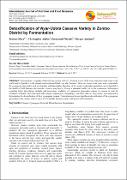| dc.contributor.author | Oloya, Benson | |
| dc.contributor.author | Adaku, Christopher | |
| dc.contributor.author | Ntambi, Emmanuel | |
| dc.contributor.author | Andama, Morgan | |
| dc.date.accessioned | 2018-06-14T09:27:33Z | |
| dc.date.available | 2018-06-14T09:27:33Z | |
| dc.date.issued | 2017 | |
| dc.identifier.citation | Oloya, Benson; Adaku, Christopher; Ntambi, Emmanuel & Andama, Morgan. (2017). Detoxification of Nyar-Udota Cassava Variety in Zombo District by Fermentation. International Journal of Nutrition and Food Sciences, 6(3), 118–121. https://doi.org/10.11648/j.ijnfs.20170603.11 | en_US |
| dc.identifier.issn | 23272694 (Print) | |
| dc.identifier.issn | 23272716 (Online) | |
| dc.identifier.uri | | |
| dc.description.abstract | Fermentation is capable of detoxifying cassava cultivars. Cassava is one of the most important food crops in the
world and in Uganda it is the second most consumed food crop after bananas. However, cassava has some toxic compounds,
the cyanogenic glycosides such as linamarin and lotaustralin. Ingestion of the toxins in abundant quantities can be harmful to
the health of both humans and animals. Cassava may hence, present a potential health risk to the consumers. Information
regarding better detoxifying methods and processing conditions of cyanogenic glycosides content in cassava is vital for
avoidance of health risks associated with cassava consumption. Accordingly, one local cultivar, Nyar-udota, was subjected to
fermentation for detoxification of their cyanogenic content. Fermentation achieved significant detoxification of the cyanogenic
glycosides in the cassava cultivar up to 64.7% and the decrease varied with period of fermentation. | en_US |
| dc.language.iso | en | en_US |
| dc.relation.ispartofseries | Vol.6;No.3 | |
| dc.subject | Cassava | en_US |
| dc.subject | Cyanogenic potential | en_US |
| dc.subject | Detoxification | en_US |
| dc.subject | Fermentation | en_US |
| dc.title | Detoxification of Nyar-Udota cassava variety in Zombo district by fermentation | en_US |
| dc.type | Article | en_US |

